
Apple revoked a certificate from Facebook, saying it violated Apple's developer policies. Without the certificate, Facebook couldn't test internal apps.Read More
from Social – VentureBeat http://bit.ly/2WwY1pg



Over the past couple weeks there was a lot of media coverage, in both traditional and social mediums discussing the Gillette “The Best a Man Can Be” ad.
The ad has a lot of layers to it.
But for the search engine marketing crowd, we know one of the most important questions is, “What was the impact on search traffic?”
What impact does creative like this have on a brand and that brand’s search volume?
This is especially interesting as we get closer to the Super Bowl. Brands have sunk millions of dollars into the ad spot and the creation of the ad itself.
Why do they make these investment choices? What is the impact to search traffic and volume?
In case you haven’t watched, here is the original video from Gillette.
Also worth watching, Saturday Night Live parodied the video using Kool-Aid as the brand.
Now that we’ve seen the ad, let’s look at the corresponding searches.
I started by looking at Google Trends for the term “Gillette.”
As expected, it spiked over the past 90 days and was the highest since 2004.
Okay, maybe this is just people looking for the commercial, or information about the Patriots since they play at Gillette stadium.
So, I took a quick look at “Gillette Razor.”
Boom! Highest search traffic volume in 5 years, and not just be a little bit, but a massive spike.
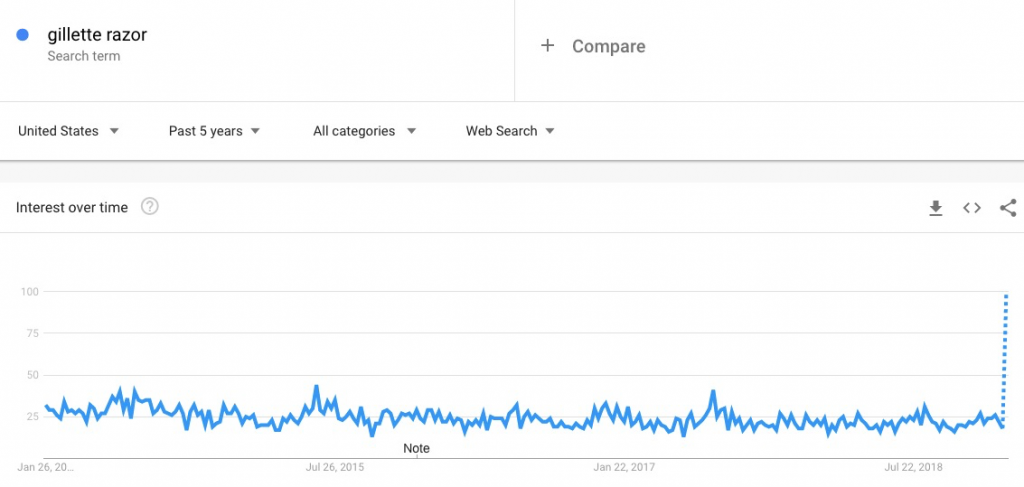
So people were also specifically driven to look for the product by branded name.
This is where the magic really happens.
Taking a look at forecasted metrics from Google’s Keyword planner over the last 12 months, you can see that the average CPC is ~$1 less per click.
If you stack that up over the course of any given day or week you will save thousands of dollars.

Gillette is probably like a lot of us and read the articles about Nike and the Colin Kaepernick ad.
This ad had a similar affect. It was divisive and took a stand, but the end goal impact to shareholders was a 31% increase in sales.
The ad launched on September 3 and the Times published an article about it on September 10.
As you can see, Nike stock was on its way to a 52 week and all-time high, and has outperformed the Dow Jones over the past 12 months.
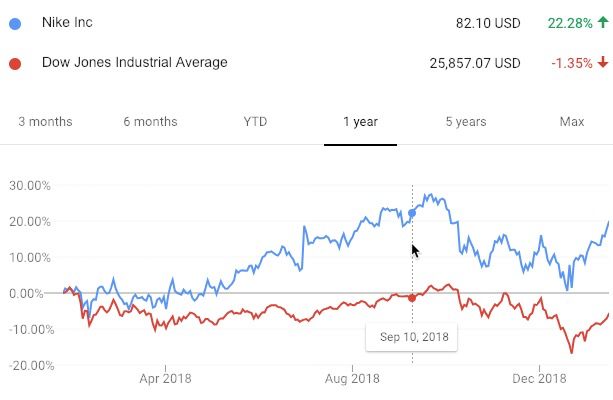
This is the type of impact that powerful branded ads can have on people.
The challenge for many of us is that we don’t have big branded budgets. We don’t work on brands that have the ability to take these types of risks.
So what information can we apply to this work in our own world?
It doesn’t have to be a branded controversial TV ad, it just needs to be good.
Look at what Dollar Shave Club has done. They came from nowhere on the back of a quality YouTube spot which now has over 25 million views.
This is true for so many other brands who have launched themselves on Facebook, or driven significant sales on a purely direct response budget to start.

Here is where a lot of brands have stepped in to challenge legacy brands, or leveraged their ability to solve problems by taking the friction out of something.
This is a big focus now with “digital transformation,” but there is a lot of truth to this when thinking about what value your ads are driving for customers.
Value can simply be selling them something they need like an iPhone charger, or removing friction from something that was previously painless, such as Uber/Lyft, or Pop sockets for phones.
Focus on the value your product is bringing and the corresponding ad space where that value is to be transacted.
This could be as simple as providing location extensions when someone is searching “running shoes” so your store can quickly and easily be found.
Help consumers get to the answer they are looking for quickly. Provide value by removing friction.
Watching how consumers move between tactics, and branded and non-branded keywords, is a great way to understand the impact of your advertising.
There are even some great ways to measure foot traffic now to help with “traditional” mediums like TV or Billboard. Doing your best to understand the measurement and inter-connectivity of your advertising will help justify these types of branded ads.
Overall, it doesn’t really matter if you liked or didn’t like the Gillette ad. The fact is it worked. It got people talking, and it drove up search traffic. Even if it has half of the impact that a similar ad had for Nike, the sales will follow.
So as much as we in search rely on consumers searching, remember there is still a lot of value in branded advertising, big and small, across mediums.
The post How did the Gillette video impact search traffic? appeared first on Search Engine Watch.

Gone are the days of SEO being a straightforward process of keyword research, on-page optimization and link building. As Google adds other factors to its algorithm and learns to assess website quality in a human-like way, SEO becomes intertwined with other marketing tactics. One of these tactics is social listening, which has been mainly used for social media marketing until recently. In this post, I explain how social listening can benefit your SEO.
First things first: let’s figure out the meaning behind “social listening”. The term describes what social media listening (also called social media monitoring) tools do. They crawl the Web, news, blogs, forums and social media platforms (Twitter, Facebook, YouTube, etc.) to find mention of any given keywords. Keywords are usually brand names, words that describe the industry or people’s names (e.g. a CEO, an author, an artist).
Using social listening for SEO requires proper knowledge and skill. It’s very important to set specific goals and know the details of how to conduct a proper search. Here’s how to go about it:
With link building still being at the core of any SEO strategy, it’s vital to cover all such opportunities. Here’s the one you might not have thought about: turning existing brand mentions into links.
If your brand has been around for a while, or if your brand, company or a specific product has had any kind of popularity at some point, it’s almost certain that there are mentions of your brand on the Internet: on blogs, forums, news sites or just somewhere on the Web. Obviously, not all of them will link back to your site: writers don’t care about promoting anyone else but themselves; they don’t have your SEO goals in mind, and the idea of linking might’ve never even crossed their minds. However, that doesn’t mean they would have a problem with adding a link if you ask them. So the only real challenge here is to find the linkless mentions. This is where social listening is relevant.
To be fair, you won’t be able to get linkless mentions with every social listening tool: you’ll need one with the Boolean search mode. With Boolean search, the user sets up the search query manually using the Boolean operators, such as AND, OR, AND NOT etc. So in the case of finding linkless mentions, the user should type their brand name as a keyword and add AND NOT link:yoursite.com/* . Tools that have Boolean search as their option include Awario (disclosure: I work for the company), Talkwalker, and Brandwatch.
Modern link building means knowing where and how your backlinks are being built. First, it’s useful to know marketing purposes: what if you can get more out of the website that already links to you? Second, you’ve got to know if your backlinks are coming from quality sites, because, as we know, links from the spammy and untrustworthy sites can seriously hurt the rankings.
With social listening, you find out about any new links anywhere on the Internet in real time. To start looking for new links, type your site’s URL in a website/web page field, which is available in most social media monitoring tools, and choose to search from limited sources: the Web plus news/blogs. This will exclude mentions that come from social media platforms (e.g. Twitter, Facebook, YouTube, etc.). You can also use the link: operator if your tool offers Boolean search.
Any SEO will tell you that guest blogging is a sound link-building strategy. It will not bring you a sudden rankings boost, but it’s a solid, tried and true way to build up your site’s reputation. This is why finding guest post opportunities is an ongoing task for many marketers. While there are always a couple of blogs that are easy to find but impossible to get featured on, there are also other blogs which are harder to find because they are not in the first two pages of Google. Yet, they might be more relevant and have a more loyal audience — that’s what usually happens in smaller communities. These blog editors are also more likely to publish your articles.
These guest blogging opportunities can be found with social listening. To find relevant blogs, type in the keywords that describe your industry (or rather a range of topics you’d like to write about) and wait for the tool to find:
There are a number of other ways to find guest posting opportunities with a social media listening tool. All of them go beyond your usual methods and are worth checking out!
In 2010, a horrible story appeared in the New York Times. In it, the author explained how negative reputation could help brands rank better in Google and cause more sales, as bad reviews generated links and buzz around the brand. The whole approach received a name: negative advertising. Merchants were acting badly on purpose, making their customers angry and, therefore, more likely to write passionate, albeit angry reviews.
Of course, that wasn’t a good thing for Google, and after the problem became apparent, they announced they incorporated an algorithmic solution to down-rank brands that provide poor user experience. We don’t know how it works now, although they talked about their “world-class sentiment analysis system” at some point. We do know it works, though. No more similar cases were in sight.
You are probably not one of those terrible marketers willing to torture their clients just to get higher in Google. However, social media crises do happen even to the best of brands with the best intentions. And a social media crisis can result not only in a long-term reputation problem but also in a serious ranking drop.
This is why it’s important to keep an eye on the sentiment around your brand. A social media tool with a built-in sentiment analysis will help you notice any suspicious spikes in time and take care of the problem before it goes viral or gets big enough for Google’s algorithm to notice.
While link building is still absolutely essential in SEO, it is becoming less and less so. You can see how passionately Google is working towards new ways of figuring out the real value of websites, understanding their content, and being more and more capable of evaluating the Internet the way humans do. And the Internet is much more than just links. These days it’s more about being popular, going viral, being heard in its various corners. And, most of all, the Internet is about social media: taken together, the single most used websites that don’t have any dofollow links.
What does it tell us? That we should shift our attention to linkless mentions. And it’s not just our speculation. In 2017, Google Webmaster Trends Analyst Gary Illyes said in his keynote at Brighton SEO the following:
“If you publish high-quality content that is highly cited on the internet — and I’m not talking about just links, but also mentions on social networks and people talking about your branding, crap like that. Then you are doing great.”
At the same time, we know that Panda patent talks about “implied links” as a signal that could be no less important than backlinks. An implied link is defined as “a reference to a target resource, e.g., a citation to the target resource, which is included in a source resource but is not an express link to the target resource”. Sounds like a mention!
This is why you should work towards growing brand mentions. With social listening, you can, firstly, track brand mentions. Knowing when, where, and in relation to what brand mentions appear will no doubt give you a much better idea as to how to grow more. For example, should your marketing strategy focus more on social media? If so, on which platforms? Or maybe, you have to move to forums and blogs (e.g., try marketing on Reddit?)
Second, you can imply new techniques of growing brand mentions, such as social selling and influencer marketing.
All the tips above can be used to monitor your competitors and discover where they get links, where they guest post, which influencers they work with, and so on. All this information can be used in your own marketing and SEO strategy.
The workflow is as straightforward as it gets: everything that you’ve done for your brand can be completed using your competitors’ brand names and URLs. Creating a different alert for every vital competitor will make the task even easier and let you see your progress compared to that of your competitors in a clear and detailed way.
Social listening is full of possibilities. It’s this new, not-totally-explored-yet technology that slowly changes the way we do digital marketing. Try using it for SEO and you might see changes you never expected to see.
The post 6 Ways Social Listening Can Help Your SEO appeared first on Convince and Convert: Social Media Consulting and Content Marketing Consulting.
One thing I’ve noticed a lot lately with websites is that no matter how it looks, the style sheet is full of redundant, duplicate, or unnecessary styles. A lot of that, I imagine, comes from updates after a website goes live, where engineers that weren’t initially involved in its development are coming in blind. Another part of that might revolve around planning or distribution of tasks for a website’s construction.
Truth be told, there are probably dozens of reasons that the styles may not be as organized or clean as they could be. We can’t see the future and we can’t always be in constant communication with one another, but I’ve learned a thing or two over the last decade that I think might help keep things clean, organized, reusable, and readable.
A few setup notes here: I write my styles with SCSS. This is my preference. There are many other options out there—Less or Sass to name a couple—which will work in more or less the same way. I also typically use webpack or Gulp on older projects to compile and minify, auto-prefix, and concatenate my style sheets.
The organization is really up to the user. There is no one right way to organize your style sheets, but I’m going to share how I organize styles and why. The why is the more important aspect for the sake of reusability.
As far as I’m concerned, there are three parts of styling a website: utilities, global elements, and unique elements.
Utilities
Utilities are things like variables, functions, or Sass mixins to help you in building your website fast and efficiently, but is rarely utilized effectively. This is the most important area for improving our processes, but we’ll come back to that.
Global Elements
Global elements are parts of your website that are used universally across the site, or in my opinion, anything that may exist on two or more pages of your website in some capacity. These are things like your typography, your grid, input or button styles, card/graphic styles, icons, etc. The large majority of your website’s styles will fit into this category.
Unique Elements
Unique elements are exactly what they sound like: some part of your website that may only exist on one part of your website. This might be something as small as that one element that shows up only on the homepage or something bigger like all single post template—shared elements that only exist in one area of your website. They can, in this case, be reusable, but aren’t part of the global scope.
Here’s where we tend to get messed up. Things that exist on a single post template, to continue the example, will also exist in the Global Elements and will probably be rendered in part by Sass mixins or variables in use. In fact, most of that template will probably be informed by the global styles unless, for some reason, it’s completely different. We might start to dirty up our code when we don’t clearly acknowledge inherency and don’t take a larger advantage of our utilities.
Styles start to get a little dirty because there isn’t sufficient effort to educate incoming developers about how things are built or what elements are used, which is why it’s infinitely important to document your code.
I don’t mean you need to write up a Github Wiki for every bit of code you write, but DocBlocks are important just as they are writing JavaScript or PHP, etc. At the very least we need to explain why things might go against the typically expected standards, overwrite global styles or if an !important is required, for example.
I take advantage of VSCode’s snippets to ensure that all of my SCSS start with a comment. At the least to determine what selector is used. We can’t always adhere to a BEM style structure, or inherently understandable class names, so it’s important to define what’s being styled if, at the least, there’s nothing else special about that block of code.
I might document minimally like:
// h2.
.title {
font-weight: bold;
} // .title.
If there’s something more involved in the block of styles, I might add a more specific note like this:
// Post Title. Overwrite parent theme.
.entry-title {
color: $color-red !important; // Force override parent theme.
font-weight: bold;
text-decoration: none;
} // .entry-title.
Of course I would do my best to style a selector in a parent theme before deciding an !important is required, but hopefully, you get my point.
I also find myself styling some object with multiple elements nested together; I separate those by an element comment to ensure each bit of styles are covered. This is a slimmed down example. Normally, I’d only implement this strategy on larger chunks of SCSS, but as an example.
//-----------------------------------------
// BLog River Post
//-----------------------------------------
//--------------------------------------------------------------
// Post River Card
//--------------------------------------------------------------
// article.
.post {
border: 1px solid $color-gallery;
background: $color-white;
padding: 1.5625rem;
//-----------------------------------------
// Post Title and Meta
//-----------------------------------------
// header.
.post-title {
font-weight: bold;
// span.
.date {
color: $color-alto;
font-weight: 400;
} // .date.
} // .post-title.
//-----------------------------------------
// Post Entry
//-----------------------------------------
// div.
.post-entry {
margin-bottom: 0;
// p. Inherits global styles.
p {
// Links in post entry.
a {
color: $color-sunshine; // Color differs from global link color.
} // a
} // p.
} // .post-entry.
//-----------------------------------------
// Post Footer
//-----------------------------------------
// footer.
.post-footer {
font-size: 0.875rem;
} // .post-footer.
} // .post.
This isn’t an immense amount of extra work in order to make sure that all of your selectors, class names and styles are documented and anything that differs from the global scope are noted. Anyone coming in after the fact should be able to gain a fairly decent understanding of what this is styling and of each element.
At this point, we’ve organized our styles simply and documented our code fairly well. The level of organization and documentation will be dependent on your company’s code standards and general workflow and preference, but this is generally pretty simple and clean so far. The next missing element in creating a more efficiently styled website is the use of built-in and custom Sass functions and mixins.
Mixins allow you to declare some SCSS that you want to reuse throughout the website. You can tie in Sass loops or functions to increase its extendability or functionality, but a general mixin might look like this:
@mixin card-style {
border: 1px solid $color-gallery;
background: $color-white;
padding: 1.5625rem;
}
And then it is used by simply calling @include card-style. This is a quick and easy way of adding easily-reusable styles to ensure that cards are consistent from page to page on your new website. I personally believe that you really shouldn’t vary from these styles for consistency’s sake—you shouldn’t have more than one similar-looking card styles on your site. But in the event that you want to extend this mixin, you could add some additional options, variables, or checks and take that simple mixin to something like this:
@mixin card-style($border: $color-alto, $background: $color-white, $padding: 1.5625rem) {
border: 1px solid $border;
background: $background;
padding: $padding;
}
This will output the same value as the card-style mixin above, but it also offers the ability to provide a custom border, background, and padding values if we like.
The goal here would be to create mixins for global elements or globally-utilized styles and document their usage. This ensures that styles for like elements are consistent, but it also cuts down on the amount of code actually needing to be written; and therefore, cuts down on the amount of time required for a project to some extent.
Mixins are quick and easy, but there are many other ways that you can help quickly style your website by leveraging more complex mixins. Let’s take a look at a mixin that can be used to output presentational background and color classes that we can utilize directly in the markup.
I’d start by creating a new Sass map. Something like this:
$theme-colors: (
alto: $color-alto,
black: $color-black,
gallery: $color-gallery,
white: $color-white,
);
This gives me an iterable list of colors we can loop through in our mixin, which would look like this at a very simple level:
@mixin colors($colors: $theme-colors) {
@each $name, $color in $colors {
// Create background color classes.
.background-#{$name} {
background-color: $color;
}
// Create color classes.
.color-#{$name} {
color: $color;
}
}
}
This can be called once and, for each color, generate a background class and color class name for use anywhere in your markup.
<footer class="site-footer background-gallery"></footer>
This would render a selector with a background color that matches our variable.
I should note that my recommendation is that only colors that will be used should be added to this Sass map. Otherwise, you’re left with unused styles in your style sheet just taking up precious bytes of space.
Really the use of mixins or functions is endless. The goal here is to create as much reusable code as possible. The more you reuse, the more consistent your website will be when it’s built and when you inevitably add or update features in the future. Incoming devs can now leverages a well-documented pre-existing library of styles in which to pull from to help avoid adding new or redundant code into your repo and keeping things clean.
The post Dev Shortie: A Better Process for Styling Websites appeared first on WebDevStudios.


It’s an addiction like any other.
Ten or twenty bucks will scratch that itch, but the high never lasts, and before long you’re craving the next hit.
And the worst part? Nobody understands.
Except just maybe a fellow addict…
“Hello. My name is Glen, and I’m a domain name junkie. My last domain purchase was three weeks, four days and seven hours ago.”
That’s how I’d introduce myself to the support group. (You know, the one that doesn’t exist yet.) I’d stand up and tell my story to a circle of fellow addicts, who’d nod their silent support.
My own addiction started with an act of vanity — I acquired the .COM version of my own name. That was 17 years ago, and owning a piece of Internet real estate was novel and exciting.
But that first domain registration, like the first high from an illicit drug, set me on the path to dependency.
Like many addicts, I failed to acknowledge my problem until it was too late.
For years I told myself buying domains was just a harmless hobby. Something to do on evenings and weekends to help unwind after work. But over time my hobby became a powerful obsession.
I’d wake up each morning with a head full of new domain ideas and a burning desire to check their availability. At social occasions, I’d sneak out of the room to browse domain resale sites on my smartphone.
And despite plans to become a savvy domain “flipper,” I was selling almost none of the domains I bought, instead keeping them for personal use.
Eventually, my behavior became more erratic. I would buy any domains I could get my hands on — .ORGs, .COs, even .INFOs.
One Monday morning I hit rock bottom when I found a dozen GoDaddy receipts in my inbox for domains that had no practical purpose. Worse still, I couldn’t even remember buying them.
These days I’m on the road to recovery, and my mission is to help other addicts.
So take a careful look at the list below, and see if you recognize any of these destructive behaviors.
If so, you might just be a domain name junkie.

When you’re a domain name junkie, you struggle to think about anything else. You spend every idle moment brainstorming cool domains for your “someday, one day” online projects.
And once an idea surfaced, you simply must know — is the name already taken? It doesn’t matter where you are, at work, at home, even in bed. You have to know.
When you discover the domain has already been taken (the good ones usually are), you start the search for viable alternatives.
And once you’ve dived down the rabbit hole, you can hardly crawl back out.
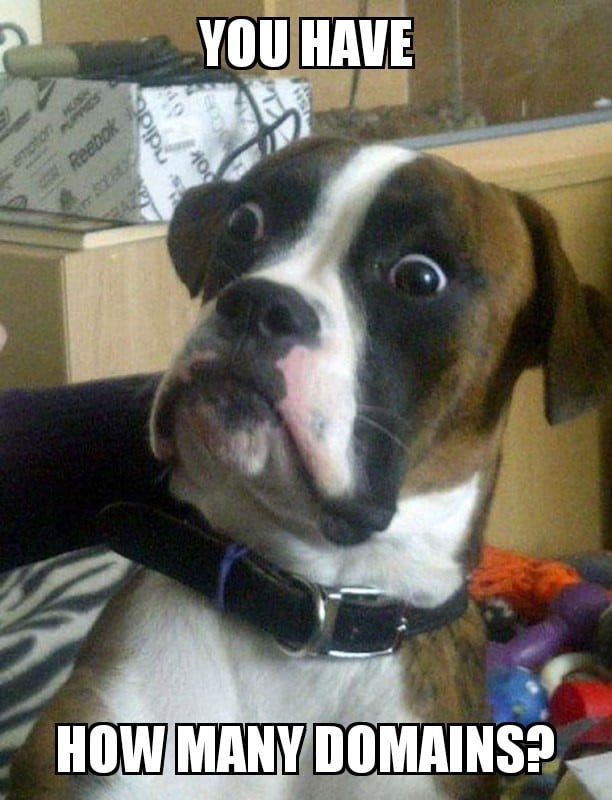
When you start collecting domains, it’s fun to log in to your account and delight in the breadth of your online kingdom.
But one day you reach the point where that list of domains is a painful reminder of a habit that’s out of control.
When your partner catches you buying yet another domain and casually asks, “How many is that now?” you pretend you don’t know, or deliberately lowball the true number.
But of course, lying is a telltale sign your casual hobby has turned into a serious problem.
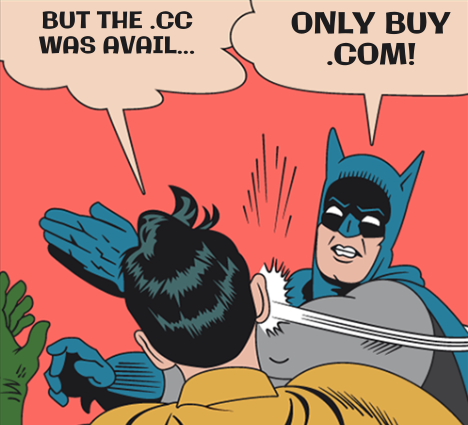
In the beginning (well, 1985), just six top-level domains (TLDs): .COM, .ORG, .NET, .EDU, .GOV and .MIL existed, but that list has since snowballed.
Today we have more than 1,500 TLDs including .COFFEE, .LAWYER and .PORN.
On the one hand, domains are more plentiful than ever, and even if your dream .COM is long gone, you have hundreds of other options for snagging a snappy name.
On the other hand, who knows how much prestige these newer domains will hold over the longer term? Nobody wants to build their blog around the domain equivalent of a pet rock.
Some domain junkies won’t look beyond .COM, but if you’re exploring the murkier end of the market (.CM anyone?), it might be a sign that your hobby’s taking a worrying turn.
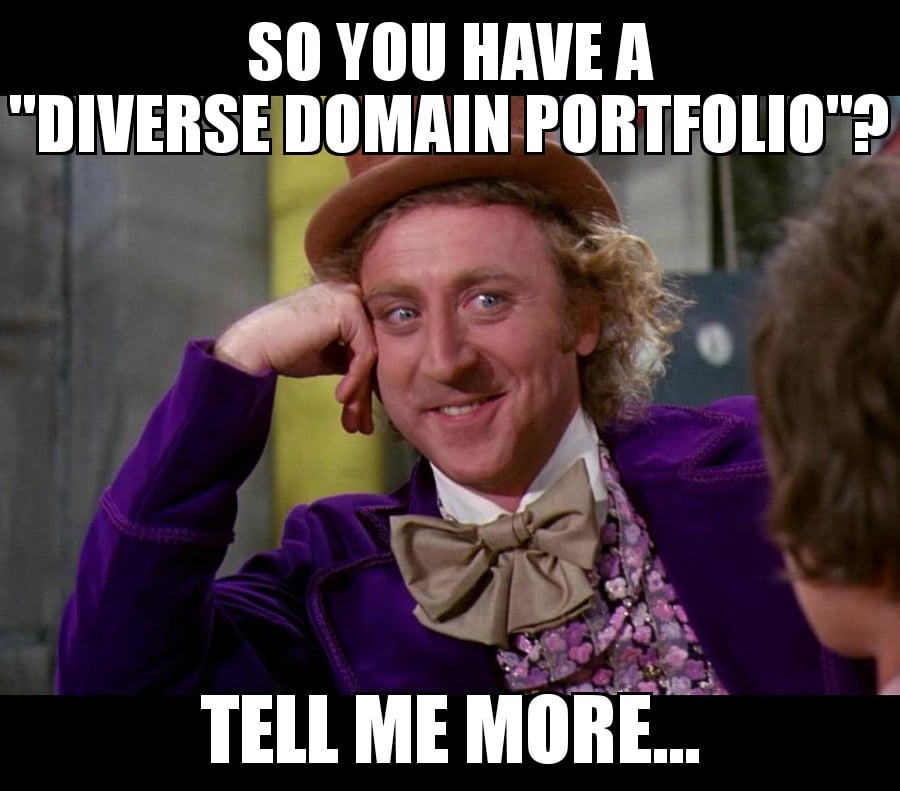
When your domain account lists tens (or even hundreds) of seemingly random domain purchases, there are two ways to explain it.
Either it’s the result of years of clueless impulse buying from a click-happy domain junkie with no more strategy than a half-blind pigeon pecking in the dirt.
Or it’s the culmination of a strategic acquisition campaign to build a valuable portfolio of undervalued digital assets for future sale.
Not surprisingly, most domain name “enthusiasts” favor the second version.
But deep down, if you suspect there’s very little method to your madness, it might be time to go cold turkey on domains.

Not every domain you dream up will be available for registration. The truth is, most won’t.
That’s why a thesaurus is a domain collector’s best friend. In fact, uncovering snappy synonyms for your latest near-miss idea can be a lot of fun.
But if a thesaurus has become your favorite bedtime read (you know, just in case a cool domain idea jumps out) it may be time to seek professional help.
Because — wake up call! — it’s a reference book, not the latest Jack Reacher.
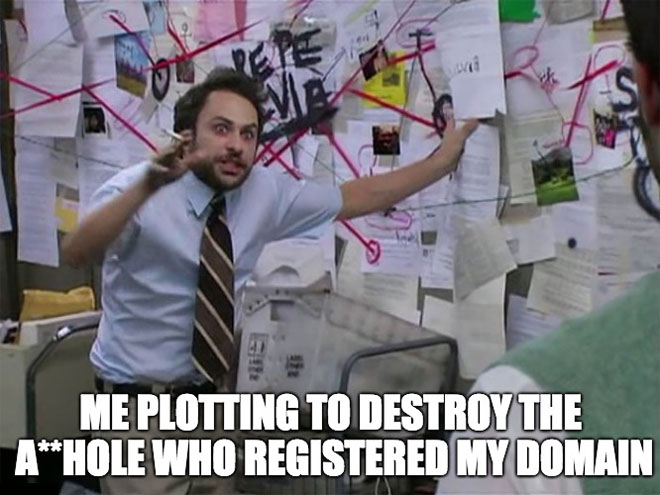
I was lucky. I grabbed my personal domain before anyone else could.
But if you have a popular birth name, or you were just too slow to the punch, your best options may already have gone. And that really stings.
Because when your name’s John Brown, telling people your treasured home on the Internet is TheRealJohnWBrown.info is plain embarrassing.
And that’s why you secretly stalk the person who nabbed your name online. You stake out their website, mentally mocking their pathetic efforts while waiting patiently for the right moment to pounce.
Because one day, they’ll forget to renew that domain and then, my friend, victory will be yours.

Sometimes you see a domain for what it is — a dumb impulse purchase you’ll never be able to use or resell.
Maybe you tried to make money by listing it for sale at a couple of domain marketplaces but didn’t get the faintest sniff of interest.
So when it comes up for renewal, you do the sensible thing and let it lapse. You even feel good about your level-headed decision.
Weeks later, you casually check to see if anyone’s re-registered it and find it’s now listed on a “premium domains” site for $3,000!
Of course, just because it’s listed for thousands doesn’t mean it’s worth thousands.
But you can’t escape the feeling you let a valuable domain slip through your fingers.
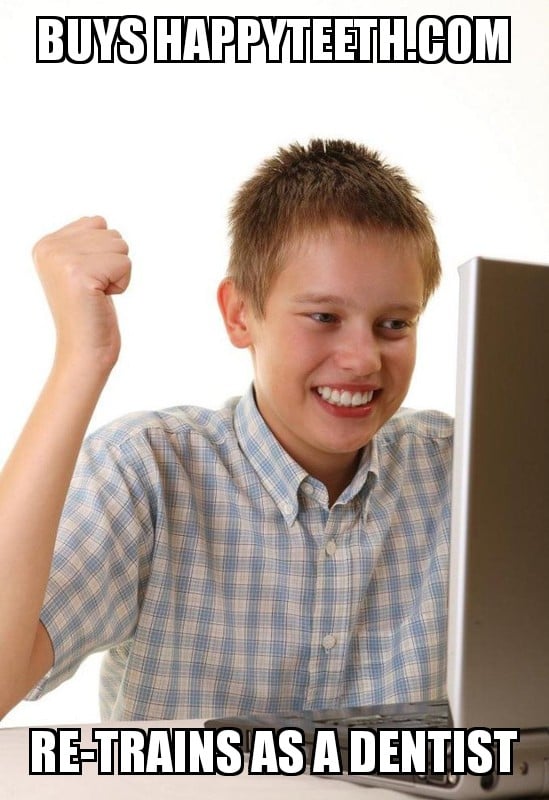
Sometimes you’ll stumble across a domain name that’s so good you simply have to own it… even though it’s totally unrelated to your work or hobbies.
The smart move would be to snag it and sell it for a profit to someone who can make good use of it. But like Gollum and that damned ring, you can’t quite bring yourself to part with it.
So your brain starts to explore a future possible world where you become the person for whom this is the perfect domain.
Sure it means throwing away years of hard-won experience and starting a blog in a new field.
But finding a domain this good must be a signal from the universe, right?
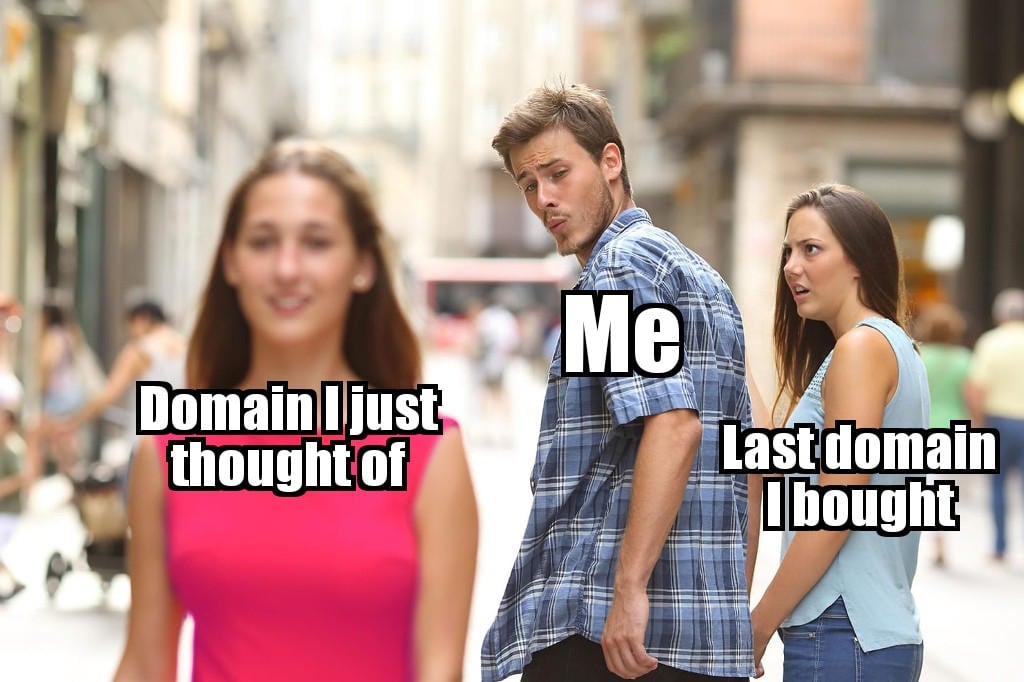
Once the buzz of snagging the name you’ve been lusting after subsides, a faint sense of regret can quickly follow.
“I can’t believe nobody bought this yet,” quickly turns to, “I can’t believe I just bought that.”
And the longer you hold onto a domain, the more money you rack up in wasted renewal fees.
The best way to take your mind off this painful predicament? Start scouting for your next domain name.
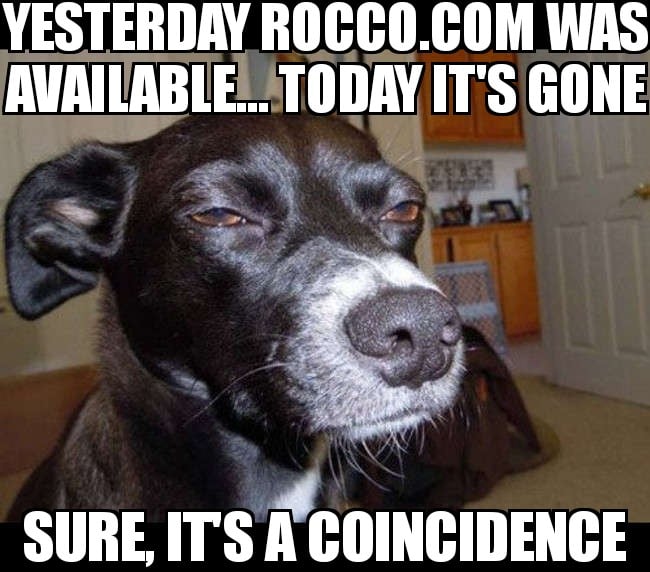
Maybe this happened to you…
One day you check a new domain and find it available for the regular price. The next day it’s suddenly a “premium” domain, commanding several thousand dollars.
And you can’t help but wonder:
Did my search alert the registrar to the juicy potential of this previously unrecognized name?
You wouldn’t be alone in your suspicions. Type “do domain registrars” into Google and “steal domains?” is the top auto-complete suggestion.
Are registrars capable of dirty tricks like this? Maybe. It’s difficult to be sure.
But paranoid thoughts like these might be the first sign your harmless hobby is turning into a dangerous addiction.
Domain name addiction is real. And it can wreck your life if you don’t catch it in time.
If you suspect you might be addicted, ask yourself the following questions:
If so, you’re likely a domain name junkie.
The good news? With the right support, a full recovery is possible.
But you must take that crucial first step. Acknowledge your addiction.
So repeat after me:
“I’m a domain name junkie. And today’s the day I get help.”
The post 10 Things You’ll Only Understand If You’re a Domain Name Junkie appeared first on Smart Blogger.
“One day, they’ll build a time machine, but no one will have the time to use it,” said George Carlin and he was right. Okay, maybe we haven’t made it to the time machine invention yet, but we certainly have to the ‘time’ part.
A couple decades ago, the basic idea was a foundation of marketing and the creative concepts were born during brainstormings and Friday night parties. Digital marketing today is all about technologies. It is different, complex and continuously evolving.
Nevertheless, for many of us, the term “marketing automation” still sounds a bit abstract. It’s like having a robot for running ad campaigns, social media management, blogging and sending email newsletters. Wait…email newsletters? What year is it?
Indeed, the future of routine automation has arrived since the broad introduction of AI and machine learning. It’s hard to imagine any other professional sphere where the number of routine tasks would measure up with marketing. That’s why it’s time to start thinking about how exactly automation can help to elevate your business to a new level or turn your brand’s weaknesses into strengths.
Does marketing automation automate marketing? Not really, but ask any marketer and it’s what they all dream of! Marketing automation is using a smart software that personalizes the brand’s message for your existing and potential customers based on customer data analysis performed by MA and AI algorithms.
The main idea of marketing automation is to eliminate routine human labor, so that employees can focus on creative and complex intellectual work. Some entrepreneurs are still skeptical about MA, since they associate technical novelties with a waste of budget. On the other hand, the issue of “standardization” and adaptation of marketing technologies is a standard practice, which was adopted by large corporations a long time ago.
Gradually, the market revealed that MA and AI integration is a gold mine that holds power to streamline promotion campaigns, increase conversion and loyalty, free up time, and alter the sales funnel. Today, when companies have realized this, medium and small-sized enterprises strive to adjust their marketing efforts to the modern automation systems that effectively deal with huge amounts of data.
As the Walker Sands State of Marketing Technology 2018 states: Around 56% of marketing specialists think that the martech industry progresses far faster than their companies can keep up with.
Dive Deeper:
Here are a few key marketing automation stats:

Spending on marketing automation tools has grown significantly during the last couple of years, and the following numbers illustrate this trend:

As you can see from the chart above, it is expected that by 2023, brands will spend $25.1 billion annually on marketing automation, and the majority of them intend to use it for cross-channel campaign management software.
Walker Sands State of Marketing Technology 2018 points out that in 2019 around 65% of marketing companies will spend more on martech, while only 5% want to decrease this spending. The majority of CMOs are actively adjusting the annual funds that they plan to invest for innovations next year.

2019 will be the year of ‘marketing automation 2.0’. Companies will invest money like never before in AI and MA-powered marketing technologies. A lot of hype was devoted to these topics in 2017 and 2018, but this year will really further new discoveries. The marketing automation solutions based on MA and AI technologies will find new implementations in customer experience personalization.
Considering that digital marketing has become more complex, the greater role has been given to communication schemes for mapping the customer experience. Development of such schemes allows you to determine the most relevant communication channels and the most successful interaction points on the customer’s journey from lead to payment.
Companies that are operating in the areas of retail, tourism and finances have been using personalization for the user’s journey for a long time. There are a myriad of tools for personalization out there, starting from those integrated into commercial processes and ending with analytical systems and independent SaaS decisions.
The following pyramid lets you determine the personalization path for your brand before strategic planning:

As we can see, eliminating manual labor was the main trend that AI brought in 2018. Along with this, we can also expect the mass personalization of web browsing experiences that was typically applied only for e-commerce websites back in 2015. Let’s take a peek now.
According to the Communications Market Report 2017, the WhatsApp messenger was used by half (50%) of the surveyed demographics, 61% used Facebook, and Snapchat was used by 28% of people. That represents 10.1 million unique visitors.

Some brands are already actively integrating these instant messengers into their applications and letting their marketing efforts benefit from such popularity. For instance, Pizza Express has been using Facebook messenger since 2017 for reserving tables at their restaurants:

And IKEA uses messengers and bots to enhance their customer satisfaction research.
Sales funnels have been transformed into automatic lead generators, with chatbots as well. Such lead-generation hooks like live chat with online consultants are applied on many websites:

In 2018, companies paid specific attention to chatbots that could function around-the-clock and generate leads everywhere: desktop, in-app or mobile. Today, your email channel can work as an independent lead generation tool along with the website. It can integrate a myriad of automation tools and effectively interact with chatbots and instant messengers.
Dive Deeper:
In 2018, search marketing retained the position of top digital sales-driving channels. Using social media is cool, but it’s running far behind search and content marketing. Why? For many B2C businesses, social media works well in terms of engaging the audience. Nevertheless, as a rule, they’re not the best suppliers of leads in narrow B2B niches according to surveys:

Search marketing is not new, and few innovations are happening currently in this area. The updates of the algorithms that result in radical search changes are rare compared to previous years when the web was affected by Penguin and Panda filters. Taking a glance at Moz’s algorithm change history in 2018, it’s hard to reveal the significant dynamics except for the “Fred” algorithm update.
In spite of this, Google Ads, for instance, introduces new features quite often: If you recall, they had a solution for managing complex variables of display advertising – ‘Google Smart Display campaigns.’ This update featured automated bidding, automated targeting, and automated ad creation that introduced advertisers to immediate ad campaign creation enabled by AI and machine learning.
What comes out of this? Content and search marketing are still on the verge of glory, and this glory is relatively stable. The integration of your search marketing in content marketing is not limited by search engine optimized articles. Your content marketing efforts can also be invested in end-to-end content mapping and ‘customer or buyer persona’ development. Using this approach, you can personify the content delivery.

Personalization can be successfully applied for streamlining email communications. Even though it’s a common fact, the majority of brands do not use such systems for mapping their customer’s lifecycle. Email Marketing and Marketing Automation Excellence clearly illustrates the point:

Created by SmartyAds
These statistics illustrate that many brands in 2018 were obviously losing marketing automation opportunities. For the email channel, the use of machine learning makes it possible to automate targeting. However, such personalization is more complicated due to the nature of emails, which are more complex and creative.
There are several ways to approach automation of email marketing from the appropriate angle. For this, you’ll have to select among CRM/email agencies, niche solutions or universal platforms for email campaigns automation, like MailChimp. Such services can detect the geolocation for each subscriber in your database. In the same way, you can tune individual design for each region, or even city, if you need it.

In addition to segmentation by countries and regions, you can target the subscribers if they stay in the vicinity of a specific city or area. Using this email targeting method, advertising was run for many music celebrities during their world concert tours.
The capabilities of machine learning are also impressive in the area of programmatic advertising and so-called Smart Bidding.
According to Forrester, programmatic will prevail in digital ad spending in 2019 and by the end of 2023 will reach $25B, which is terrific in comparison to $11.4 billion in 2017.
Most search-driven manual advertising campaigns (even those performed with professional tools) take into account three or four targets: the keyword, time of the day, and location. Such tools like programmatic demand-side platform can use hundreds of targeting signals to individualize the advertisement and even target according to lifestyle or behavior habits when integrated with customer data platforms.

In order to develop a programmatic strategy, first of all, you should decide who your audience is and what you plan to achieve by addressing them directly. Programmatic advertising is not limited to a single goal and can be used to achieve different results. Even though programmatic delivers the highest conversions due to fine-tuned personalization, in fact, it can be used in every stage of the customer’s journey.
Dive Deeper:
In analytics and optimization, almost everything falls into the category of ‘repetitive routine tasks,’ and analytics is what helps marketers understand what works and what doesn’t.
If you’re following the marketing trends, then you probably know that the modern marketing landscape might be lacking an essential component – a tool that would easily integrate and consolidate the data from various paid media.
The good news is, these services exist but they’re frequently too expensive, especially if they offer additional analytical tools. They are not marketing technologies that directly impact the number of leads or sales, considering that you also need to analyze this data and react to it appropriately.
The analysis of the data sources in the shape it exists today will soon vanish. It will become AI-powered, automated, scaled, quick, intuitive, and visual. Do you want to be impressed? Then go to Google Analytics and click on ‘Assistant’ in the left navigation bar or on the Data-Driven Attribution. You will see a glimpse of the future of AI-based data analytics, even though it’s so far mostly manually operated.

Marketing automation reduces the degree of uncertainty that marketing professionals have to deal with on a daily basis. As soon as your website traffic reaches a couple hundred visitors, you can’t possibly track each one manually. Here’s where marketing automation comes in handy.
In the same way with emails, if you can’t send welcome letters to everyone who has registered or make offers based on their interests, use automation. Such decisions don’t only solve the problem with time-consuming daily routines, but also personalize and streamline the processes with user communications.
The post 5 Trends that Will Define the New Vision of Marketing Automation appeared first on Single Grain.
Here at Search Engine Watch we have written quite extensively over the years about how to optimize your YouTube videos to make sure they really stand out.
Ann Smarty’s top 5 tips from last year is a handy list. And for YouTube best practice, Pius Boachie’s post is a great read too.
As 2019 gets going, video is still growing as a great way to ensure visibility online and to provide web users with useful and engaging content.
It is also an increasingly competitive medium.
YouTube doesn’t disclose how many creators use the platform. And there’s obviously quite some difference between someone who posts daily and has 100k+ followers, versus anyone who’s ever once uploaded a video. Estimates, though, range from 50m to upwards of 150m.
We do know that YouTube has more than 1.8 billion monthly users — nearly rivaling Facebook’s 2.27 billion.
Optimizing your YouTube channel, then, should not be an afterthought.
Those who are really succeeding on YouTube have great channels. They look good, they showcase their best videos and they connect with others in their niche. They are a destination in their own right.
And they promote better engagement and more views of the videos there. This is massively important when it comes to having your videos rank in YouTube’s (and Google’s) SERPs.
Channel art in the case of YouTube refers to the banner that stretches across the top of the page in-between the search bar and the title of the channel.
It goes without saying that this should be eye-catching and on-brand – as well as being sized to the optimal 2560 x 1440 pixels – but it can be so much more.
It can also be a place to share important information about the channel, such as what day of the week videos are uploaded. Sam The Cooking Guy is a good example:

As you can see, this banner is prime real estate for getting some key information across with Sam telling us what days of the week he posts new content. He also has a Call To Action (right hand side) for persuading us to subscribe, as well as links to his merch store, Facebook, Instagram and Twitter right in the banner too.
YouTube also gives you the option to have a featured video or – for users who aren’t yet subscribed – a channel trailer.
Many successful channels opt to place a video they see as good example of the rest of their content. But, of course, it is possible to have more success with getting users to subscribe by making a for-purpose trailer about your channel.
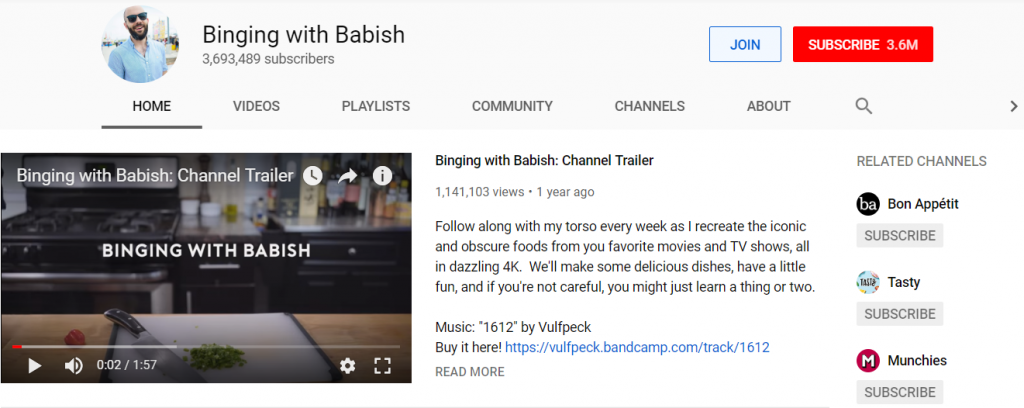
Either way, be sure to use the description box to full effect by including around 100 words (or about 500 characters) to signal to visitors and the Google/YouTube algorithm what your channel is all about.
In the above example, Binging with Babish is very kindly linking out to Vulfpeck. But I would also recommend there being a CTA with links out to your website from here – it’s a really visible part of the page.
Once you really start building up your YouTube content, playlists certainly help make things more navigable.
Grouping together popular videos or those with a similar theme are good options. You will know your content best when it comes to working out what videos work well together. There’s no hard and fast rule here.
Remember, from an SEO point of view, videos which are getting good traffic and engagement tend to rank better.
So, make videos as easy to find by grouping and linking out to other similar videos/playlists in your channel from each video description. This will make things easier for viewers.
Don’t just rely on YouTube to get your content next in-line after other similar videos.
Be bold with playlists and link to them.
It’s not the most visible page, but YouTube does provide an ‘About’ tab for you to add a description for your channel.
By the looks of things, you can be as wordy as you like here. You can also add a business email and links to website/social media/etc.
Links within the body text there aren’t clickable – but there’s a designated link area at the foot of the page.
Linking out to the competition might seem a little odd, but it is in keeping with the community spirit of YouTube.
I find it best to think about it in terms of giving value to you visitors/subscribers. Make it easy for them to browse other great and relevant content.
Be part of the conversation.
Make sure you are uploading the best content that you can. And you might just find other channels start linking to you.
YouTube channels can really be used to great effect to ensure your video content is as visible as possible.
Good channel art, putting your best content front and center, and making your growing collection of video content more navigable via playlists and links are really important.
Graham Charlton points out in his piece How to optimize your videos for better ranking in YouTube that there are a great number of ranking factors that go into YouTube’s algorithm.
I’d argue a well-optimized channel is a good way for pushing up some important ones.
Note: the YouTube Creators Academy is also a great resource. Check it out!
YouTube is quite generous in what it allows you to do.
If your video content is strong and well optimized – you owe it to yourself to make sure the channel in which it resides shines too.
The post YouTube SEO: Optimizing your channel in 5 steps appeared first on Search Engine Watch.
Practical Ecommerce publishes roughly 45 articles per month. Our mission, since 2005, is to publish independent content — articles, podcasts, seminars — that help online merchants. What follows are the most popular articles that we published in January. Articles published earlier in the month are more likely to make the list than later ones.
The post January 2019 Top 10: Our Most Popular Posts appeared first on Practical Ecommerce.
The percentage of U.S. searchers clicking on advertisements in Google search results is growing. Likewise, the percentage of visitors that click nothing is also growing. But the percentage of visitors that click natural search listings is shrinking.
The post Rise of Mobile Users Alters SEO Tactics appeared first on Practical Ecommerce.

Recently, Tatiana Morand, a content and SEO manager, asked her employer for a raise. She got it.
Content marketer Allison Gagliardi asked for 10% raises at two previous employers. Both times, she got the salary bump.
How? Both of them say they didn’t just ask for a raise. They made a case for it. They spent the time evaluating the market, understanding their worth, and making a well-documented persuasive case to their supervisors.
Don’t ask for a raise. Make the case for it. @AnnGynn #marketing
Click To Tweet
“Compensation rates are based on two factors – the value you are able to provide to your company, and the competitive landscape and salary in your field,” says Stacy Caprio, founder of Growth Marketing.
Should your compensation be higher? If so, how should you get it?
Let’s tackle both questions to see if and how you should address the salary conversation in 2019.
Start your search by investigating what others in your industry, role, and region are making. What’s the average? How does your salary measure up?
The Creative Group 2019 Salary Guide is a good place to start. It details how companies are finding it challenging to hire for content marketing roles in this competitive landscape. The gated content also covers 85 positions in the creative and marketing industry and details the highest, middle, and lowest compensation rates for each job.

Median salary for a #content manager is $62,750, @CreativeGroup 2019 #salary guide. #marketing
Click To Tweet
You can also use The Creative Group’s Salary Calculator to customize the figures for your city.
Tatiana, who successfully asked for a raise at Wild Apricot, suggests pulling market data from your area. She looked at Glassdoor and LinkedIn when making her case.
Before asking for a raise, pull local market data using sites like @glassdoor or @linkedin, says @queen_morand.
Click To Tweet
HANDPICKED RELATED CONTENT:
Simply doing your job likely isn’t enough to earn a compensation increase. Long before you ask for a salary bump, ask your supervisors about the business’s goals and the key performance indicators related to your role.
Before you ask for salary bump, ask about the business’s goals & KPIs related to your role, says @Ayothewriter.
Click To Tweet
“Dazzle them and try to go well beyond their expectations,” says Ayodeji Awosika, director of digital marketing, MLT Group – Creative Solutions. “Follow the rules of writing great content for marketing and SEO. Match searcher intent with your posts. Write 10-times content nobody can replicate and provide real insights – me-too content doesn’t impress search engines or your supervisors.”
Think about ROI. For example, “track the leads you receive from inbound marketing on Google Analytics, assign value to those leads (total revenue produced/total number of quality leads), and give them a clear picture of exactly how your content marketing is growing the business,” Ayodeji says.
Tatiana took a similar approach when she made her pitch for a raise. “I prepared a full report showing my value to my organization, focusing on the metrics I knew were most important to them,” she says. “This showed I understood our overarching business metrics and can connect my role to a larger strategy rather than focusing solely on content.”
TIP: Don’t go for the fluff. Instead of saying, “I published 10 blog posts this month,” say how those blog posts influenced business results.
HANDPICKED RELATED CONTENT:
As a content marketer, you already appreciate the value of knowing your audience and crafting a story that resonates with it. Do the same for your compensation story, says Graham Shorr, who got his start as a copywriter and is now director of growth at SquareFoot.
Use #contentmarketing to ask for raise. Know the audience. Craft a story that resonates. Graham Shorr @TheSqFt
Click To Tweet
“Some managers are highly analytical and solely focused on measurable results,” Graham says. In these cases, you should use data to explain your impact at each stage of your funnel.
“Other managers really value the fact that you can start and finish projects without handholding,” he says. “An emphasis on hitting deadlines and your cadence of getting high-quality work out the door will go a long way.”
TIP: Don’t think of your request for higher compensation as a one-off campaign. Build a regular cadence of measuring and reporting success.
Allison says she made her case to two employers, both internet marketing agencies, in the annual review process.
With the first employer, she had been a content editor for three years and had received the annual 3% raises most everybody received. Then she made her case for and received a 10% increase. She took a similar tactic a few years later as a senior content manager at another agency. In her first-year performance review there, she asked for and received a 10% raise.
How did she make the successful presentations? She wrote a letter outlining her compensation request and listed her accomplishments to date in a bullet format. She signed the letter – with an actual pen – and put it in a two-pocket folder. In the other pocket, she included emails/letters from clients and co-workers singing her praises. “It’s proof they just can’t argue with,” Allison says.
Based on her success, Allison offers a few tips for making your presentation:
Be creative about your consolation prize suggestions. Allison offers some suggestions: a bonus if a certain benchmark is achieved, permission to bring your dog in the office on certain days, a standing desk, an air card (for Wi-Fi wherever you go), an improved title, a continuing education plan, or even control of the AC unit in your department (no, for real).
Jordan Wan, founder and CEO of CloserIQ, offers a few more tips to keep in mind when negotiating a raise:
Remind your employer you enjoy working there. Don’t make a #salary conversation all about money. @jordanxwan
Click To Tweet
And if your employer can’t or won’t boost your salary? Consider moving along. That’s what Growth Marketing’s Stacy did awhile back. “When I left an agency marketing company to go to a finance company to do their marketing, I received a $30,000 instant raise.”
When you’re negotiating, consider asking for a continuing education benefit like a trip to Content Marketing World Sept. 3-6. Use the code BLOG100 and save $100. Register today.
Cover image by Joseph Kalinowski/Content Marketing Institute
The post How to Get the Content Marketing Salary You Deserve appeared first on Content Marketing Institute.